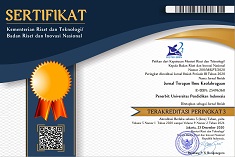Game Analysis of Scoring Strokes in Men's Singles and Men's Doubles Badminton
Abstract
Keywords
Full Text:
PDFReferences
Abián, P., Castanedo, A., Feng, X. Q., Sampedro, J., & Abian-Vicen, J. (2014). Notational comparison of men’s singles badminton matches between Olympic Games in Beijing and London. International Journal of Performance Analysis in Sport, 14(1). https://doi.org/10.1080/24748668.2014.11868701
Alcock, A., & Cable, N. T. (2009). A comparison of singles and doubles badminton: heart rate response, player profiles and game characteristics. International Journal of Performance Analysis in Sport, 9(2). https://doi.org/10.1080/24748668.2009.11868479
Alkhawaldeh, I. M., & Altarawneh, M. (2023). Effect of Trait and State Anxiety on Overhead Defensive Clear Shot Skill Performance Regarding Some Kinematic Variables for Badminton Players. Asian Journal of Sports Medicine, 14(3). https://doi.org/10.5812/asjsm-138373
Armstrong, C., Reid, M., Beale, C., & Girard, O. (2023). A Comparison of Match Load Between Padel and Singles and Doubles Tennis. International Journal of Sports Physiology and Performance, 18(5). https://doi.org/10.1123/IJSPP.2022-0330
Cabello Manrique, D., & González-Badillo, J. J. (2003). Analysis of the characteristics of competitive badminton. British Journal of Sports Medicine, 37(1). https://doi.org/10.1136/bjsm.37.1.62
Chow, J. Y., Seifert, L., Hérault, R., Chia, S. J. Y., & Lee, M. C. Y. (2014). A dynamical system perspective to understanding badminton singles game play. Human Movement Science, 33(1). https://doi.org/10.1016/j.humov.2013.07.016
Faude, O., Meyer, T., Fries, M., & Kindermann, W. (2009). Physiological testing in badminton. In A. Lees , D. Cabello, G. Torres, (Eds.), Science and Racket Sports IV, IV.
Gawin, W., Beyer, C., & Seidler, M. (2015). A competition analysis of the single and double disciplines in world-class badminton. International Journal of Performance Analysis in Sport, 15(3). https://doi.org/10.1080/24748668.2015.11868846
Hughes, M., & Meyers, R. (2005). Movement patterns in elite men’s singles tennis. International Journal of Performance Analysis in Sport, 5(2). https://doi.org/10.1080/24748668.2005.11868331
Iwatsuki, T., Takahashi, M., & Van Raalte, J. L. (2016). Effects of the intention to hit a disguised backhand drop shot on skilled tennis performance. International Journal of Sports Science and Coaching, 11(3). https://doi.org/10.1177/1747954116644063
Lee, K. T., Xie, W., & Teh, K. C. (Sports M. and R. C. (2005). Notational Analysis of International Badminton Competition. ISBS.
Liu, W., Zhou, Z., Shen, Y., & Zhang, H. (2022). Stroke performance relevance model for elite table tennis matches. International Journal of Performance Analysis in Sport, 22(4). https://doi.org/10.1080/24748668.2022.2089514
Milon, A. G. (2014). Study Regarding The Complexity Of Physical Training In Badminton. Scientific Journal of Education, Sports, and Health, XV(1).
Morgans, L. F., Jordan, D. L., Baeyens, D. A., & Franciosa, J. A. (1987). Heart rate responses during singles and doubles tennis competition. Physician and Sportsmedicine, 15(7). https://doi.org/10.1080/00913847.1987.11702030
Phomsoupha, M., & Laffaye, G. (2020). MULTIPLE REPEATED-SPRINT ABILITY TEST WITH FOUR CHANGES OF DIRECTION FOR BADMINTON PLAYERS (PART 2): PREDICTING SKILL LEVEL WITH ANTHROPOMETRY, STRENGTH, SHUTTLECOCK, AND DISPLACEMENT VELOCITY. Journal of Strength and Conditioning Research, 34(1). https://doi.org/10.1519/JSC.0000000000002397
Sheng, Y., Yi, Q., Gómez-Ruano, M. Á., & Chen, P. (2022). The Influence of Technical and Contextual Variables of the Last Stroke on Point Outcome in Men’s and Women’s Singles Badminton. Frontiers in Psychology, 12. https://doi.org/10.3389/fpsyg.2021.802179
Terry, P. C., Cox, J. A., Lane, A. M., & Karageorghis, C. I. (1996). Measures of anxiety among tennis players in singles and doubles matches. Perceptual and Motor Skills, 85(2). https://doi.org/10.2466/pms.1996.83.2.595
Wang, W. Y., Chan, T. F., Peng, W. C., Yang, H. K., Wang, C. C., & Fan, Y. C. (2022). How Is the Stroke? Inferring Shot Influence in Badminton Matches via Long Short-term Dependencies. ACM Transactions on Intelligent Systems and Technology, 14(1). https://doi.org/10.1145/3551391
Xiao, C., & Tasnaina, N. (2025). Development of a Badminton Teaching Program Based on Visual Searching Feedback. International Journal of Sociologies and Anthropologies Science Reviews. https://api.semanticscholar.org/CorpusID:275659277
DOI: https://doi.org/10.17509/jtikor.v9i2.81820
Refbacks
- There are currently no refbacks.
Copyright (c) 2025 Tian Kurniawan, Agus Rusdiana, Tono Haryono, Iwa Ikhwan Hiidayat, Angga Muhammad Syahid, Finaldhi Palgunadi, Septian Wiliyanto, Reshandi Nugraha, Riansyah Riansyah

This work is licensed under a Creative Commons Attribution-NonCommercial-ShareAlike 4.0 International License.





